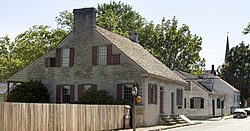Ste. Genevieve Historic District | |
 Felix Vallé State Historic Site, within the historic district | |
| Location | Ste. Genevieve, Missouri |
|---|---|
| Coordinates | 37°58′37″N 90°02′55″W / 37.97696°N 90.048672°W |
| Built | 1750 |
| Architectural style | Colonial |
| NRHP reference No. | 66000892 and 02000357 |
| Significant dates | |
| Added to NRHP | October 15, 1966, boundary increase April 11, 2002[1] |
| Designated NHLD | October 9, 1960[2] |
The Ste. Genevieve National Historical Park, established in 2020, consists of part or the whole of the area of the Ste. Genevieve Historic District, which is a historic district encompassing much of the built environment of Ste. Genevieve, Missouri, United States. The city was in the late 18th century the capital of Spanish Louisiana, and, at its original location a few miles south, capital of French Louisiana as well. A large area of the city, including fields along the Mississippi River, is a National Historic Landmark District designated in 1960, for its historically French architecture and land-use patterns, while a smaller area, encompassing the parts of the city historically important between about 1790 and 1950, was named separately to the National Register of Historic Places in 2002.[2][3][4][5][6]
Ste. Genevieve is home to one of the highest concentrations of distinctive types of French colonial architecture known as poteaux en terre, or post in ground, and Poteaux-sur-sol, or post on sill. Both of these styles involve construction of walls consisting of vertical logs, the former placed directly into the ground, and the latter onto a horizontal sill of wood or stone. Prominent local examples of these architectural styles include the Beauvais-Amoureux House, the Felix Vallé House State Historic Site, La Maison de Guibourd, the Delassus-Kern House, and the Louis Bolduc House (itself listed separately as a National Historic Landmark). In 2018, the National Park Service was authorized to establish Ste. Genevieve National Historical Park as a unit of the U.S. national park system, following a favourable study by the park service. It joined the park system on October 30, 2020.
- ^ "National Register Information System". National Register of Historic Places. National Park Service. April 15, 2008.
- ^ a b "Ste. Genevieve Historic District". National Historic Landmark summary listing. National Park Service. Archived from the original on January 7, 2013. Retrieved June 14, 2008.
- ^ Charles W. Snell (December 12, 1968). National Survey of Historic Sites and Buildings Supplementary Sheet: Ste. Genevieve. National Park Service. and Accompanying nine photos from 1959 and 1967 (32 KB)
- ^ Stephen Lissandrello (May 8, 1975). "National Register of Historic Places Places Inventory - Nomination Form: Ste. Genevieve Historic District" (PDF). Missouri Department of Natural Resources State Historic Preservation Office. Retrieved February 1, 2016.
- ^ Douglas C. McVarish (October 2001). "National Register of Historic Places Registration: Ste. Genevieve Historic District". National Park Service. Retrieved April 8, 2023. Includes 37 accompanying photos and maps. NRHP reference #02000357.
- ^ Douglas C. McVarish (October 2001). "National Register of Historic Places Multiple Property Documentation Form: Historic Resources of Ste. Genevieve, Missouri". National Park Service. Retrieved April 8, 2023. NRHP reference #64500786.


